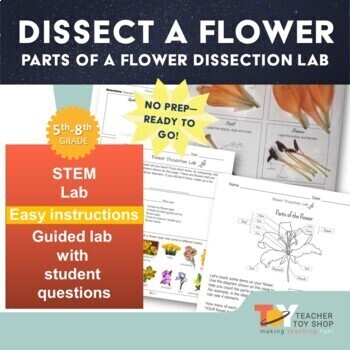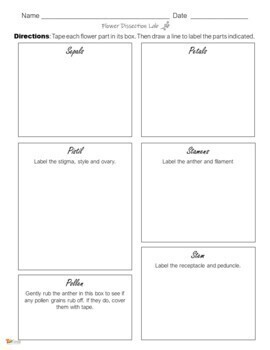Parts of a Flower Dissection Science Lab
- PDF
- Easel Activity
What educators are saying
Also included in
- Looking for a comprehensive and engaging bundle to teach all about the parts of a flower? Download Parts of a Flower Unit - Worksheets, Activities, Labs, and More! This all-inclusive bundle is designed to equip educators with everything needed to seamlessly teach flowering plant reproduction, makingPrice $17.99Original Price $28.22Save $10.23
- All of Teacher Toy Shop's Life Science resources in one place! Some biology topics included: cells, ecosystems, human body systems and organs, flowers, reproduction, human eye, and more. Includes NGSS aligned lessons, experiments using the Scientific Method, and more.Purchase this bundle for a low-pPrice $49.99Original Price $80.66Save $30.67
Description
Discover the fascinating world of plant biology with this engaging Parts of a Flower Dissection Science Lab resource! This comprehensive activity is designed to provide students with a hands-on experience in understanding the intricate details of flower anatomy through a guided dissection process. Perfect for biology classes, this science lab enhances learning through interactive worksheets, detailed instructions, and captivating graphic organizers. This resource also aligns with the Girl Scouts Junior Flowers badge requirements, making it a valuable addition to scouting activities!
Equip your students with a deeper understanding of science through this engaging flower dissection activity. Watch as they explore the wonders of plant reproduction and grasp the intricacies of the parts of a flower. Distance learning? No problem! Students can participate by accessing and printing the provided pages, along with acquiring flowers, tape, and scissors. Transform your biology lessons with this comprehensive science lab, designed to foster curiosity and hands-on learning.
► What's Included?
✔ Teacher instructions and materials list for easy implementation
✔ Suggestions for optimal flower types to dissect, ensuring a successful lab experience
✔ Student-friendly lab experiment worksheet pages that guide them through the dissection process
✔ Parts of a flower diagram to reinforce learning and aid in labeling
✔ Answer key with detailed photos of dissected flowers (lily and alstroemeria) for reference
⚠️ BUNDLE & SAVE! ⚠️ Download the complete Parts of a Flower Unit and save on everything you need to teach flower reproduction!
You Might Also Like...
- Pop-Up Flower STEM activity—Terrific for reinforcing the parts of the flower!
- Flowers are Parents?— Engaging and HILARIOUS reading comprehension for your students!
✪ Don't forget to follow Teacher Toy Shop to be the first to know about new products, sales and freebies!








